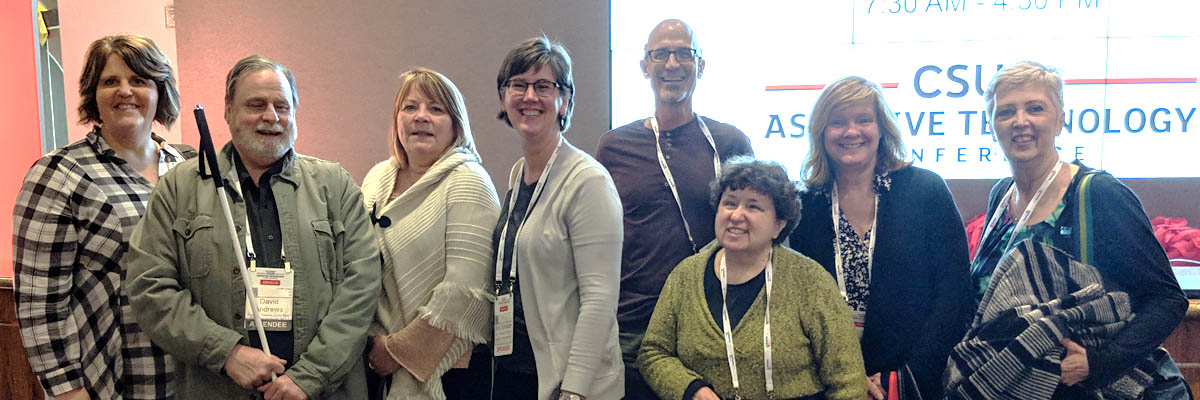State of Minnesota Accessibility Staff Share Their Experiences
4/29/2019 11:00:23 AM

Pictured above from left to right: Kim Wee, David Andrews, JoAnn Rautio, Kris Schulze, Jay Wyant, Lolly Lijewski, Kim Sandrock, Lois Butcher.
In March, eight State of Minnesota employees arrived at the 2019 CSUN Assistive Technology Conference. Their goal? Learn as much about digital accessibility as they could in four days, then bring back the information to Minnesota and apply it to their work.
We asked five of the attendees to share with us more about what they learned, the impact of the experience, and information they thought might help our readers. In case you missed it, March’s Office of Accessibility newsletter includes links to session handouts.
Lolly is the digital accessibility coordinator in the Minnesota Department of Human Services’ Compliance Office.
CSUN 2019 was so chock full of excellent sessions, it was hard to choose. In any session time slot, I could find four to six sessions I wanted to attend.
I learned about:
The conference was most enjoyable and extremely valuable. As CSUN is an international conference, we were exposed to presenters from all over the world.
It was so exciting to be amongst so many people who were passionate about accessibility! #A11Y
Lois is an administrative assistant at the Minnesota Department of Transportation’s Office of Research and Innovation.
As a first-time attendee of the CSUN conference, I wasn’t quite sure what to expect. Starting with the keynote address, I became very aware of what a valuable experience the conference would be. There were so many takeaways, but my favorites were:
My mind was buzzing with ideas by the time I got back home. I have been sharing ideas and training opportunities with anyone who will listen or has need of this information. I am so grateful that the Minnesota Department of Transportation granted me the opportunity to attend.
Kim Wee is the webmaster and accessibility coordinator for Minnesota IT Services, partnering with the Minnesota Department of Education.
A session which continues to impact my work was called Coaching and Celebrating Your Accessibility Champions (Link to Slideshare handouts). A key take away was that they built out three different teams or levels of champions. The presenters described how this cascaded into thousands of people. That was intriguing to me because we have accessibility coordinators at the State of Minnesota but we really want to have more accessibility champions across the state. I will keep this in mind when we talk about how we build capacity here at the state, how you get more buy-in from state employees, and how to get more people interested in becoming accessibility champions.
JoAnn is the accessibility coordinator for Minnesota IT Services partnering with the Minnesota Department of Employment and Economic Development.
To continue to develop my expertise in accessibility testing, I attend CSUN whenever I can. I get hands-on time with new products, like Microsoft Accessibility Insights and JAWS Inspect, and information updates about axe, WAVE, JAWS and other tools I use as part of my work.
CSUN gives me the opportunity to address bugs and issues I have with those accessibility testing products directly with the vendor and the programmers of the software. This type of access to these individuals provides better opportunities to troubleshoot together. I also have the ability to make recommendations on how to improve the tool for users like me and other State of Minnesota employees. This makes our jobs more efficient!
Kim Sandrock is the training coordinator for the Minnesota Department of Health’s Public Health Laboratory.
A picture I took at CSUN is of a slide from WebAIM’s presentation where they tested over a million web pages for accessibility errors. At the end of the presentation is a question, “What are you going to do about it?” I thought that was a great way to end the presentation, by calling on us to take the information we learn at the conference back home with us and to make changes that will make a difference.
I learned a lot of valuable information, a lot of which was technical accessibility information. But I think the most important thing I learned was that my job as an Accessibility Coordinator for my division is not just to meet legal requirements, but to impact our global society by making valuable information accessible for all.
Would you like to learn more about the accessibility work being done by Minnesota IT Services and the State of Minnesota? Once a month we will bring you more tips, articles, and ways to learn more about digital accessibility.
Accessibility